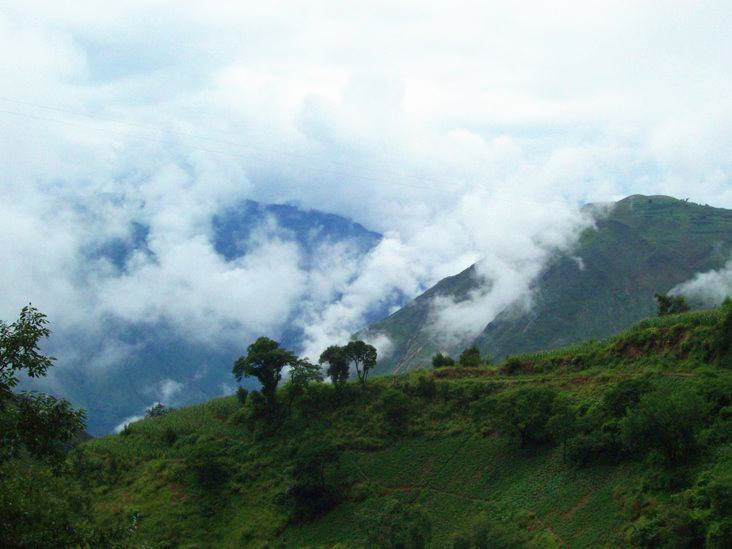Wumengshan Mountain in Dongchuan District, Kunming
Overview of Wumengshan Mountain
Wumengshan Mountain (乌蒙山) is the watershed between the Jinsha River (金沙江) and the Beipan River (北盘江). It is located in the northern part of the Yunnan-Guizhou Plateau (滇东高原) and the northwestern part of the Guizhou Plateau (贵州高原). Stretching in a northeast-southwest direction, it is a young mountain range formed by fault uplifting. Most of its composition is ancient limestone, with an average altitude of around 2,000 meters and the highest peak reaching 4,000 meters. The mountain rises 500 to 1,000 meters above the surrounding plateau.
The region is rich in karst topography, with numerous basins, deeply cut valleys, isolated hills, limestone erosion basins, and underground rivers. The scenery includes majestic karst formations like sinkholes, limestone valleys, and mysterious caves.
A Poetic Tribute by Mao Zedong
The grandeur of Wumengshan is vividly captured in the famous verse by Mao Zedong (毛泽东):
“Wumeng is so vast, it feels like we are treading on mud balls.”
(乌蒙磅礴走泥丸)
This poem encapsulates the powerful and rugged landscape of the Wumeng Mountains.
Dagu Niu Zhai (大牯牛寨)
Dagu Niu Zhai (大牯牛寨) is the highest peak in the Wumengshan Range, exuding an imposing aura. The mountain is only 9 kilometers from Dongchuan City (东川城区), but it rises dramatically with a height difference of 2,767.3 meters, an extraordinary geological feature. Most of the mountain consists of hard limestone, appearing brownish in color. From both near and far, the peaks tower majestically, and the cliffs are sharp and awe-inspiring.
During spring and summer, as visitors approach the foot of the mountain, they walk through vast grasslands filled with vibrant wildflowers. The slopes are adorned with blossoming camellias, adding to the beauty of the landscape. Occasionally, the sight of wild mountain goats racing across the cliffs adds excitement to the breathtaking scenery.
The Crash Site of the American “Flying Tigers” Squadron
At an altitude of 3,000 meters on Xiaogu Niu Peak (小牯牛峰), there is a historic site commemorating the crash of an American “Flying Tigers” plane during World War II. This site attracts many adventurers and history enthusiasts, eager to uncover its mysteries.
Other Scenic Highlights
The mountain is also home to legendary spots like Yunmen Pass (云门关) and Xianren Cave (仙人洞), set amidst towering peaks and deep valleys. These locations offer stunning views of high-altitude karst caves and underground rivers. From the mountain’s summit, visitors can witness clouds flowing below and the subtropical town at the base of the mountain, providing a striking experience of the phenomenon: “One mountain, four seasons; ten miles, different weather.” (一山有四季、十里不同天)
Dagu Niu Zhai (大牯牛寨) – The Highest Peak
Dagu Niu Zhai (大牯牛寨) is located at the border between Dongchuan District (东川区), Kunming, and Huize County (会泽县), Qujing City (曲靖市). It is the highest peak in the Wumengshan Range and is known for its grandeur. The name “Dahai” (大海) comes from the Yi language (彝语), meaning “above the steps,” referring to the terraced landscapes leading to the highest point of the range, Dagu Niu Zhai, which stands at an altitude of 4,017.3 meters. This peak is also the highest point in Qujing City, while the lowest point is where the Xiaojiang River (小江) meets the Jinsha River (金沙江), with a vertical difference of 3,322.3 meters.
The Dagu Niu Zhai landscape is characterized by vast alpine and subalpine meadows, providing visitors with wide, open views and a sense of awe.
A Description from the “Dongchuan Gazetteer” (东川府志)
The Dongchuan Gazetteer records the following about Dagu Niu Zhai:
“The peaks are perilously high, always shrouded in clouds. On clear days, the greenery appears vividly, visible from over four to five hundred miles away in central Yunnan.”
(垂冈绝巘,危峰矗立,常有云气覆之,每天晴日朗,苍翠欲滴,滇中四五百里皆见之)
Climbing to the peak, although one may not feel like they are on top of the world, they cannot help but be filled with pride, inspired by the grandeur of the landscape.
Dramatic Elevation Changes
Dagu Niu Zhai has one of the most dramatic elevation changes, with weather that varies significantly depending on altitude. Visitors often remark on the experience of “traveling through four seasons in a single day, and encountering different weather within ten miles.” This unique feature contributes to its fame.
Western Slope – Jiangjia Ravine (蒋家沟)
On the western slope of Dagu Niu Zhai lies Jiangjia Ravine (蒋家沟), one of the largest and rarest debris flow zones in the world, known for its dramatic mudslides. This natural phenomenon is both awe-inspiring and dangerous, drawing geologists and tourists alike.
Eastern Slope – Lush Grasslands
On the eastern slope, clear springs flow year-round, and the meadows are covered in lush green grass, resembling a natural carpet that stretches endlessly. Visitors can often spot herders wearing traditional white wool cloaks, guiding their flocks of sheep across the expansive grasslands. This serene image evokes the peaceful coexistence between people and nature in this rugged yet beautiful landscape.
Reflection
Dagu Niu Zhai exemplifies the harmonious relationship between nature’s might and human endeavor. It serves as a reminder of the wisdom found in respecting nature’s rhythms while integrating human life into the landscape. Whether for adventure, history, or simply to experience breathtaking scenery, Wumengshan Mountain remains a must-visit destination for nature lovers and explorers.
















